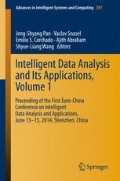Abstract
With explosive growth of the Internet, the amount of information in text form is growing rapidly and the demand for data analysis is also increases. We can perform sentiment analysis on a large set of text messages to discover valuable knowledge and obtain enormous benefits in national security, business, politics, economics, etc. However, text messages from the social networks are rather different from those of traditional text documents. Therefore, it is difficult but essential to develop an effective method of sentiment exploration in social networks. In this paper we first applied a neural network model, namely the self-organizing maps, to cluster similar messages and sentiment keywords, respectively. We then developed an association discovery process to find the associations between a message and some sentiment keywords. The sentiment of a message is then determined according to such associations. We performed experiments on Twitter messages and obtained promising results.
Access this chapter
Tax calculation will be finalised at checkout
Purchases are for personal use only
Preview
Unable to display preview. Download preview PDF.
References
comSCORE: It’s a social world: Top 10 need-to-knows about social networking and where it’s headed (2011), http://www.comscore.com/Insights/Presentations_and_Whitepapers/2011/it_is_a_social_world_top_10_need-to-knows_about_social_networking
Nielsen: Social media report 2012: Social media comes of age (2012), http://www.nielsen.com/us/en/newswire/2012/social-media-report-2012-social-media-comes-of-age.html
Lipsman, A., Mudd, G., Rich, M., Bruich, S.: The power of like: How brands reach and influence fans through social media marketing (2011), http://www.comscore.com/Insights/Presentations_and_Whitepapers/2011/The_Power_of_Like_How_Brands_Reach_and_Influence_Fans_Through_Social_Media_Marketing
Krikorian, R.: New tweets per second record, and how! (2013), https://blog.twitter.com/2013/new-tweets-per-second-record-and-how
Kohonen, T.: Self-Organizing Maps. Springer, Berlin (2001)
Kohonen, T., Honkela, T.: Kohonen network. Scholarpedia 2(1), 1568 (2007)
Turney, P.D.: Thumbs up or thumbs down?: Semantic orientation applied to unsupervised classification of reviews. In: Proceedings of the 40th Annual Meeting on Association for Computational Linguistics, ACL 2002, pp. 417–424. Association for Computational Linguistics, Stroudsburg (2002)
Pang, B., Lee, L., Vaithyanathan, S.: Thumbs up?: Sentiment classification using machine learning techniques. In: Proceedings of the ACL 2002 Conference on Empirical Methods in Natural Language Processing, EMNLP 2002, vol. 10, pp. 79–86. Association for Computational Linguistics, Stroudsburg (2002)
Pang, B., Lee, L.: Seeing stars: Exploiting class relationships for sentiment categorization with respect to rating scales. In: Proceedings of the 43rd Annual Meeting on Association for Computational Linguistics, ACL 2005, pp. 115–124. Association for Computational Linguistics, Stroudsburg (2005)
Snyder, B., Barzilay, R.: Multiple aspect ranking using the Good Grief algorithm. In: Proceedings of the Joint Human Language Technology/North American Chapter of the ACL Conference (HLT-NAACL), pp. 300–307 (2007)
Thelwall, M., Buckley, K., Paltoglou, G., Cai, D., Kappas, A.: Sentiment in short strength detection informal text. J. Am. Soc. Inf. Sci. Technol. 61(12), 2544–2558 (2010)
Kim, S.M., Hovy, E.: Identifying and analyzing judgment opinions. In: Proceedings of the Main Conference on Human Language Technology Conference of the North American Chapter of the Association of Computational Linguistics, HLT-NAACL 2006, pp. 200–207. Association for Computational Linguistics, Stroudsburg (2006)
Hu, M., Liu, B.: Mining and summarizing customer reviews. In: Proceedings of the Tenth ACM SIGKDD International Conference on Knowledge Discovery and Data Mining, KDD 2004, pp. 168–177. ACM, New York (2004)
Author information
Authors and Affiliations
Corresponding author
Editor information
Editors and Affiliations
Rights and permissions
Copyright information
© 2014 Springer International Publishing Switzerland
About this paper
Cite this paper
Yang, HC., Lee, CH., Wu, CY., Huang, YC. (2014). Discovering Sentiment of Social Messages by Mining Message Correlations. In: Pan, JS., Snasel, V., Corchado, E., Abraham, A., Wang, SL. (eds) Intelligent Data analysis and its Applications, Volume I. Advances in Intelligent Systems and Computing, vol 297. Springer, Cham. https://doi.org/10.1007/978-3-319-07776-5_23
Download citation
DOI: https://doi.org/10.1007/978-3-319-07776-5_23
Publisher Name: Springer, Cham
Print ISBN: 978-3-319-07775-8
Online ISBN: 978-3-319-07776-5
eBook Packages: EngineeringEngineering (R0)

